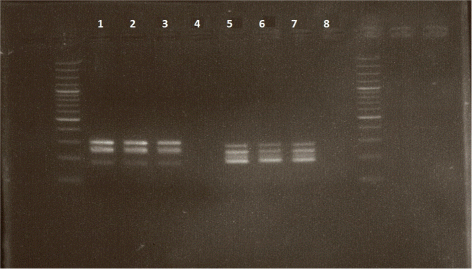Multiplex pyrosequencing assay using AdvISER-MH-PYRO algorithm: a case for rapid and cost-effective genotyping analysis of prostate cancer risk-associated SNPs
- PMID: 26108440
- PMCID: PMC4630960
- DOI: 10.1186/s12881-015-0186-x
Multiplex pyrosequencing assay using AdvISER-MH-PYRO algorithm: a case for rapid and cost-effective genotyping analysis of prostate cancer risk-associated SNPs
Abstract
Background: Single Nucleotide Polymorphisms (SNPs) identified in Genome Wide Association Studies (GWAS) have generally moderate association with related complex diseases. Accordingly, Multilocus Genetic Risk Scores (MGRSs) have been computed in previous studies in order to assess the cumulative association of multiple SNPs. When several SNPs have to be genotyped for each patient, using successive uniplex pyrosequencing reactions increases analytical reagent expenses and Turnaround Time (TAT). While a set of several pyrosequencing primers could theoretically be used to analyze multiplex amplicons, this would generate overlapping primer-specific pyro-signals that are visually uninterpretable.
Methods: In the current study, two multiplex assays were developed consisting of a quadruplex (n=4) and a quintuplex (n=5) polymerase chain reaction (PCR) each followed by multiplex pyrosequencing analysis. The aim was to reliably but rapidly genotype a set of prostate cancer-related SNPs (n=9). The nucleotide dispensation order was selected using SENATOR software. Multiplex pyro-signals were analyzed using the new AdvISER-MH-PYRO software based on a sparse representation of the signal. Using uniplex assays as gold standard, the concordance between multiplex and uniplex assays was assessed on DNA extracted from patient blood samples (n = 10).
Results: All genotypes (n=90) generated with the quadruplex and the quintuplex pyroquencing assays were perfectly (100 %) concordant with uniplex pyrosequencing. Using multiplex genotyping approach for analyzing a set of 90 patients allowed reducing TAT by approximately 75 % (i.e., from 2025 to 470 min) while reducing reagent consumption and cost by approximately 70 % (i.e., from ~229 US$ /patient to ~64 US$ /patient).
Conclusions: This combination of quadruplex and quintuplex pyrosequencing and PCR assays enabled to reduce the amount of DNA required for multi-SNP analysis, and to lower the global TAT and costs of SNP genotyping while providing results as reliable as uniplex analysis. Using this combined multiplex approach also substantially reduced the production of waste material. These genotyping assays appear therefore to be biologically, economically and ecologically highly relevant, being worth to be integrated in genetic-based predictive strategies for better selecting patients at risk for prostate cancer. In addition, the same approach could now equally be transposed to other clinical/research applications relying on the computation of MGRS based on multi-SNP genotyping.
Figures



References
-
- Goh CL, Saunders EJ, Leongamornlert DA, Tymrakiewicz M, Thomas K, Selvadurai ED, Woode-Amissah R, Dadaev T, Mahmud N, Castro E, et al. Clinical implications of family history of prostate cancer and genetic risk single nucleotide polymorphism (snp) profiles in an active surveillance cohort. BJU International. 2013;112(5):666–73. doi: 10.1111/j.1464-410X.2012.11648.x. - DOI - PMC - PubMed
-
- Kader AK, Sun J, Reck BH, Newcombe PJ, Kim ST, Hsu FC, et al. Potential impact of adding genetic markers to clinical parameters in predicting prostate biopsy outcomes in men following an initial negative biopsy: findings from the reduce trial. Eur Urol. 2012;62(6):953–61. doi: 10.1016/j.eururo.2012.05.006. - DOI - PMC - PubMed
-
- Butoescu V, Ambroise J, Stainier A, Dekairelle AF, Gala JL, Tombal B. Does genotyping of risk-associated single nucleotide polymorphisms improve patient selection for prostate biopsy when combined with a prostate cancer risk calculator? The Prostate. 2014;74(4):365–71. doi: 10.1002/pros.22757. - DOI - PubMed
Publication types
MeSH terms
LinkOut - more resources
Full Text Sources
Other Literature Sources
Medical

